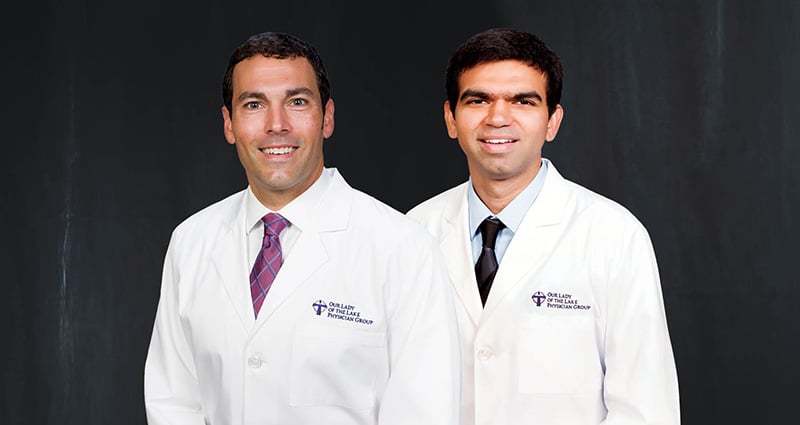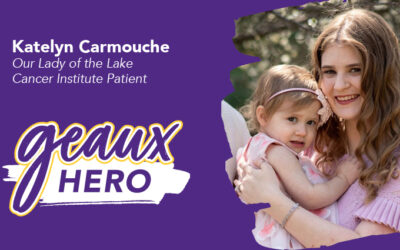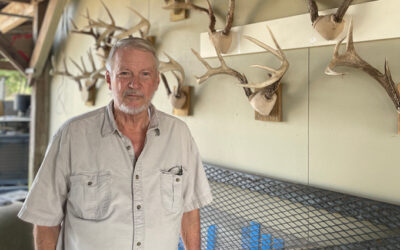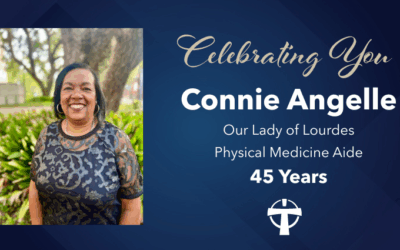Lung cancer remains the leading cause of cancer deaths in the U.S., making early detection crucial for effective treatment and improved survival rates.
The most effective strategy for combating lung cancer starts with prevention — primarily through avoiding smoking or quitting if you are a smoker. Our health system is at the forefront of diagnosing and treating lung cancer, improving outcomes for patients in the communities we are privileged to serve.
Multidisciplinary Care, Tailored for You
Facing a lung cancer diagnosis can be daunting for patients and their families. At Our Lady of the Lake Cancer Institute, a dedicated multidisciplinary team, including thoracic surgeon Nick LeBlanc, MD, and pulmonologist Abdulla Majid-Moosa, DO, provides comprehensive care tailored to each patient’s unique needs. They emphasize the importance of collaboration, communication and a patient-centered approach in the fight against lung cancer.
In this conversation, Dr. LeBlanc and Dr. Moosa highlight the importance of incidental lung nodule programs like the one at Our Lady of the Lake, which are finding cancer that otherwise would go undetected.
Lung Cancer Screening: Who Should Be Tested?
While the best way to combat lung cancer is through prevention, early detection significantly increases the chances of successful treatment. So, who should be screened for lung cancer, and at what age?
“The general recommendations suggest that anyone aged 50 to 80 with a smoking history of at least 20 pack-years should enroll in lung cancer screening,” Dr. Moosa says. “This includes individuals who still smoke or those who have quit within the last 15 years.”
For context, a “pack-year” is defined as smoking one pack of cigarettes daily for one year. Thus, someone who smokes two packs a day for 10 years would also meet the criteria with a 20-pack-year history.
Understanding Lung Cancer Risk Factors
Though smoking is the primary risk factor, others, like secondhand smoke, environmental pollutants and radiation from previous treatments, can increase lung cancer risk. Patients with higher risk may benefit from more intensive screening protocols, especially using low-dose CT scans, which studies have shown improve survival rates.
Discussing your specific risks with your primary care provider is essential. Early-stage lung cancer often has no symptoms, partly due to the vast lung surface area. Small nodules may go unnoticed unless close to an airway.
Early Detection and Rapid Response
Our incidental lung nodule program catches cancers early through scans taken for unrelated reasons. X-rays, CT scans or other images from ER visits or routine care can reveal nodules, which are then reviewed by a dedicated team of specialists.
“It’s a phenomenal program that catches otherwise missed cancers,” Dr. LeBlanc says.
The lung nodule conference brings together various specialists, including thoracic surgeons, pulmonologists, interventional radiologists, hematologists and oncologists, ensuring concerning scans are meticulously evaluated.
“After a collective discussion we conclude on the best next step for that patient,” Dr. Moosa says. “Those recommendations are then taken back to the patient and their team of providers to facilitate the next steps in their care.”
A benefit of our multidisciplinary team is evident in how swiftly we can move patients from diagnosis to treatment.
“It’s not infrequent for us to discuss an incidental finding and move through diagnosis, staging and treatment — surgery, radiation or otherwise — all within a few weeks,” Dr. LeBlanc says.
Ultimately, our patients benefit, and providers improve their skills through the process, too. “I’m constantly getting perspectives from others,” Dr. Moosa says.
World-Class Robotic Surgery
Our Lady of the Lake is home to the most advanced robotic program in Louisiana, enabling us to offer minimally invasive surgical options.
Dr. LeBlanc explains the advantages of robotic surgery: “Patients undergoing lobectomies can often go home the same day or within 24 hours, with minimal pain and scarring.”
By using robotic technology, we significantly reduce recovery times, allowing patients to return to their daily lives much quicker.
A Commitment to Patient-Centered Care
Ultimately, the goal of our multidisciplinary team is to provide patient-centered care that addresses not just the physical but also the emotional and spiritual needs of our patients. Dr. Moosa and Dr. LeBlanc encourage patients to lean on their support systems and spiritual beliefs during a challenging time.
By harnessing the collective expertise of our multidisciplinary team, we deliver the best possible care, ensuring each patient feels supported every step of the way. This collaborative model not only enhances the quality of care but also provides patients with a sense of confidence and reassurance in their treatment journey.




